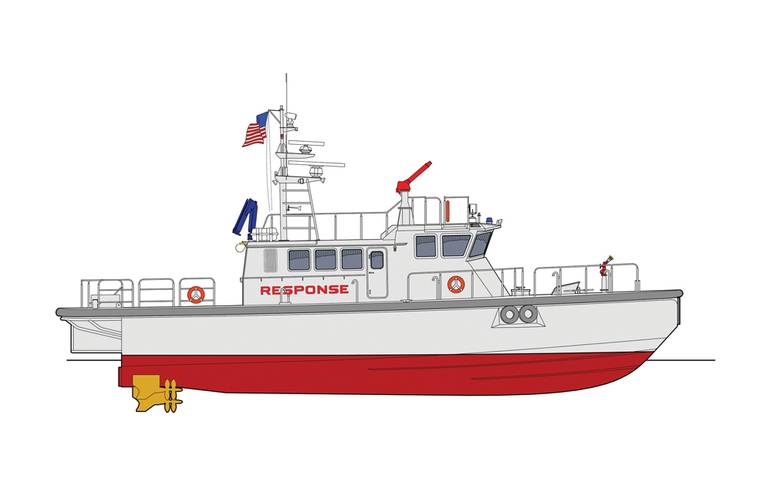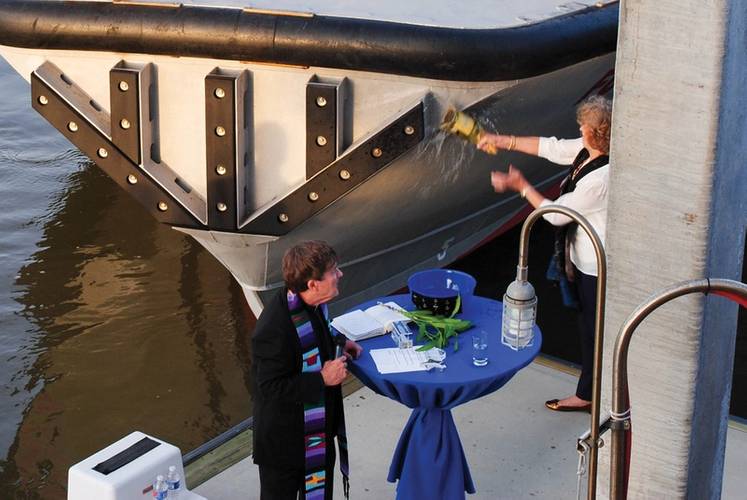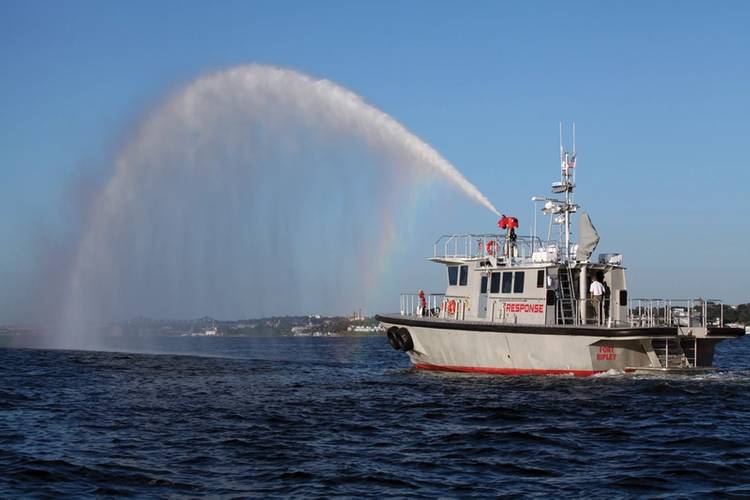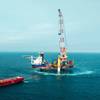Fort Ripley: Multi-Missioned & Fully Capable
On a beautiful Autumn afternoon in Charleston, SC last month, MarineNews Editor Joseph Keefe had the good fortune to attend the christening on the nation’s first dual purpose, rapid response vessel and pilot launch. As the first vessel to be designed for offshore salvage and firefighting requirements, it was also notably the first commercial application of Volvo Penta’s IPS drive propulsion. The vessel also represents an interesting twist in the Charleston Branch Pilots’ business model. The pilot game is already a pretty good paying gig, but clearly, this group is thinking outside the box. So, too, were the designers, builders and propulsion providers when they dreamed up and brought to fruition the M/V “Fort Ripley.”
With a Tier III compliant propulsion arrangement that burns 30 percent less fuel than any of the other three vessels in the Charleston Pilot fleet, the vessel’s long range endurance will eventually allow it to respond to maritime casualties all along the mid-Atlantic coastline. Diver and hotel ready, and capable of pumping 3,500 gallons per minute in firefighting mode, the new delivery is a welcome addition to the port of Charleston.
The gala event included attendees from C. Raymond Hunt (designers), Gladding Hearn Shipyard (the builders), Volvo Penta and virtually every stakeholder in the greater Charleston waterfront community. Arguably, though, the highlight of the day was a guided tour and short excursion aboard the versatile vessel. Humming along in the bay – scarcely a tremor in the vessel’s spacious and high tech wheelhouse – the vessel’s captain was asked how fast the boat was moving. The boat’s captain simply smiled and simply pointed to the speed gauge: 28+ KT. In short, the well-designed “Fort Ripley” is destined to have real impact in the Palmetto State. Looking beyond that, it is clear that Volvo Penta’s turnkey IPS propulsion package will soon have the same effect on the North American workboat scene.
The Fort Ripley, powered by triple Volvo Penta IPS drives, is a U.S. Coast Guard-certificated 64-ft. aluminum boat, owned by Southeast Ocean Response Services Inc. Built by Gladding-Hearn Shipbuilding, Duclos Corporation, and designed by C. Raymond Hunt Associates, the boat’s primary mission will be to allow ships to meet federal requirements for rapid offshore firefighting, salvage and emergency response, providing coverage between Morehead City, N.C., and St. Augustine, Fla. It will also serve as a fireboat in Charleston Harbor, a supply boat for ships at anchor and an additional launch for the Charleston Pilots and other marine operators in the region.
The three IPS drives, each powered by a commercially rated Volvo Penta D13-700 diesel engine, are independently steerable, with dual counter-rotating forward-facing propellers to maximize efficiency and increase maneuverability. The IPS can be controlled from the wheelhouse or either of the two aft docking stations using a three-axis joystick. The Dynamic Positioning System (DPS) provides fully automatic hands-off precise station-keeping under GPS control. The triple engine configuration allows the center engine to decouple from the drive and power a 3,500-GPM fire pump while the two outboard drives easily maneuver the vessel to maintain position automatically using DPS.
John Cameron, President, Southeast Ocean Response Services, said, “We chose the Volvo Penta triple IPS system because it has the power we need to get offshore to the scene of an incident rapidly, while also having the versatility to provide dedicated power to the fire pump as needed. Certainly, the predicted 30 percent improved fuel efficiency, which we actually exceeded in trials, along with the EPA Tier III technology, made this system the obvious choice.”
“Fort Ripley is a truly revolutionary boat,” said Ron Huibers, President, Volvo Penta of the Americas. “The combination of the Hunt-designed hull and our IPS drives with DPS sets a new standard in terms of speed, maneuverability, fuel economy and seaworthiness to meet multiple mission requirements. This vessel represents the future of the next generation of multi-purpose response boats.”
In addition to its 3,500 GPM dual-monitor foam firefighting system, Fort Ripley features a diver platform, dual-purpose breathing apparatus recharging system, 1,000-pound crane, four-ton deck cargo capacity, VHF and satellite voice communications, day/night cameras with satellite data uplink, and a PYROLANCE steel-penetrating nozzle system. It is U.S. Coast Guard certificated for a 12-person response team. Multi-missioned, economical to run, U.S.-built and designed, and environmentally compliant, Fort Ripley is arguably the quintessential definition of the modern workboat: nothing left to chance, and everything included. The Charleston Pilots have, quite possibly, changed the business model for harbor pilots everywhere. As a minimum, the blueprint is now clear. And “multi-missioned” is the catch phrase.
(As published in the November 2014 edition of Marine News - http://magazines.marinelink.com/Magazines/MaritimeNews)




















